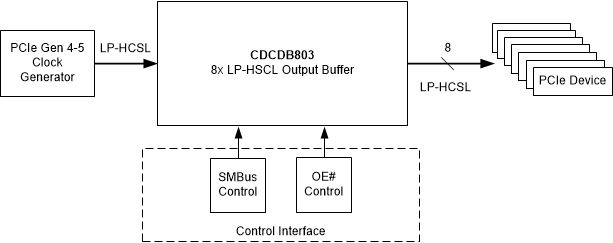SNAS820A August 2021 – May 2022 CDCDB803
PRODUCTION DATA
- 1 Features
- 2 Applications
- 3 Description
- 4 Revision History
- 5 Pin Configuration and Functions
- 6 Specifications
- 7 Parameter Measurement Information
- 8 Detailed Description
- 9 Application and Implementation
- 10Power Supply Recommendations
- 11Layout
- 12Device and Documentation Support
- 13Mechanical, Packaging, and Orderable Information
Package Options
Mechanical Data (Package|Pins)
- RSL|48
Thermal pad, mechanical data (Package|Pins)
- RSL|48
Orderable Information
9.2 Typical Application
Figure 9-1 shows a CDCDB803 typical application. In this application, a clock generator provides a 100-MHz reference to the CDCDB803 which then distributes that clock to PCIe endpoints. The clock generator may be a discrete clock generator like the CDCI6214 or it may be integrated in a larger component such as a Platform Controller Hub (PCH) or application processor.
 Figure 9-1 Typical Application
Figure 9-1 Typical Application